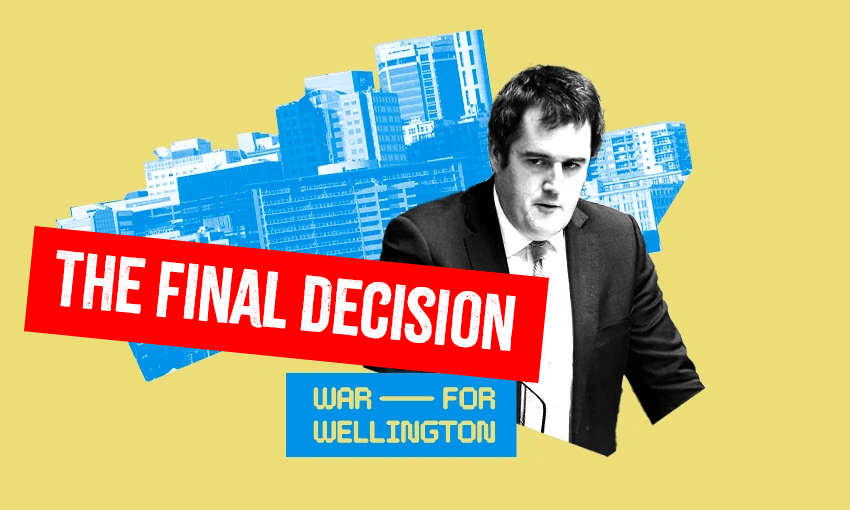The District Plan is a blueprint for a bigger, better Wellington, through tens of thousands of new apartments and townhouses and a new approach to urban growth. Joel MacManus lays out the vision.
The process of putting together Wellington’s new District Plan has been long and excruciating. As a city, we spent years arguing about density, character protections and housing affordability through the Spatial Plan and District Plan processes. With housing minister Chris Bishop’s sign-off yesterday, it’s finally over.
It’s no secret that Wellington has been going through a bit of a tough time lately. The pipes leak, the transit is underperforming, and most of the coolest buildings are closed for earthquake repairs. Wellington doesn’t have the same GDP or population growth as Auckland, and worst of all, Gen Xers who were around in the ’90s keep telling me the city isn’t as cool as it used to be.
If we embrace it wholeheartedly, the new District Plan could be the path forward out of the city’s malaise. Not everyone will agree with all of it, but it is a plan, and it’s the best one we’ve got. The District Plan is a blueprint for a bigger, better city, through tens of thousands of new apartments and townhouses and a new approach to urban growth.
A study released yesterday by Sense Partners, commissioned by Greater Wellington Regional Council, compared how housing density affects the cost of infrastructure to local government across Wellington. The results are almost perfectly linear: the higher the density of the area, the lower the cost of infrastructure per dwelling. The solution is obvious. Wellington will only fix its problems by growing. More people and more homes means more ratepayers to cover the costs of better infrastructure, better transit and better civic services.
A larger, denser population will also mean a more powerful city economy with more productive, high-tech jobs, and patrons to support a more vibrant arts and culture scene. Density has plenty of other advantages too, like lower emissions, cheaper house prices and better access to services.
But arguing about the merits of density is kind of a false debate in Wellington anyway. There are some parts of New Zealand that can have that discussion. Christchurch could realistically reach a population of one million with suburban sprawl alone. Auckland already did. Wellington simply doesn’t have room. The hills and harbour limit the amount of flat land. Wellington doesn’t have a choice between high-density growth and low-density growth. It has a choice between high-density growth, or stagnation.
So now that the District Plan has passed, what can Wellingtonians do to support the future of their city? For starters, we should wholeheartedly embrace our identity as a growing city. We should take pride in new housing developments and taller buildings as symbols of our city’s progress, rather than trying to fight them.
In the next few years, someone might try to build a new apartment building near your house. You may feel uncomfortable about how it changes the street you know and love. Some of your neighbours may try to oppose it (although they will have a much harder time under the new rules). I’d encourage you to reframe that worry – it’s not just change, it’s progress. It will mean more homes for people, more customers for local businesses, and better outcomes for the city.
We need to embrace the things that support density, too: public green spaces, pedestrianised areas, and space-efficient transport like bike lanes, bus lanes, trains and maybe even (*gasp*) light rail. It’s not a debate about whether you like cars or not, it’s simply physically impossible for Wellington to grow while still being car-dependent.
Wellington is already more compact and denser than any other city in New Zealand. The path forward is to double down on that, embrace it and make it part of our identity. It’s a point of difference and can be a point of pride. The capital isn’t like any other city in this country, and it doesn’t need to be. It can be better.
A quick note on heritage
Housing minister Chris Bishop rejected amendments by the council to remove heritage protections for 10 buildings, including the Gordon Wilson flats and the Miramar Gas Tank. That’s the headline most media ran with, and it’s a point that generated a lot of outrage online. I chose not to focus on it too much, because those 10 buildings are a relatively small point relative to a plan that will completely change the future of housing in our capital city.
But for what it’s worth, I think Bishop has done the right thing here. I know he absolutely despises the Gordon Wilson flats, and would have happily knocked them down if he could. It seems the council’s amendment lacked the evidence needed for him to legally remove the heritage listings. It would have required some kind of expert evidence to suggest those buildings didn’t warrant a heritage listing – not just that the heritage listings were inconvenient and annoying.
There is still a huge problem in Wellington and nationally with heritage buildings that are earthquake damaged or otherwise inhospitable but can’t be torn down. There clearly needs to be some kind of reform to allow councils to remove heritage protections, but it would be better to do that through an actual law change rather than rely on piecemeal repeals once every 20 years when a council passes a new District Plan.

